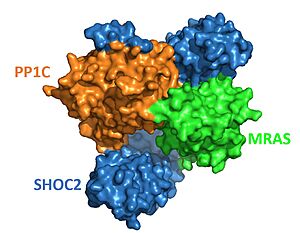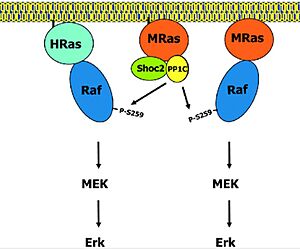Sandbox Reserved 1777
From Proteopedia
(Difference between revisions)
| Line 47: | Line 47: | ||
Because of this complex's key role in the regulation of the MAPK-RAF pathway, minor changes can be deleterious. Unregulated activation of the MAPK pathway is known to be one of the most common causes of human cancer. This is due to unchecked cell division and proliferation which are the common trademarks of cancer. Cancer is thought to be so prevalent from this pathway because it stabilizes the interactions of the SMP complex members and consequently enhances holophosphatase activity (cite, AACR). | Because of this complex's key role in the regulation of the MAPK-RAF pathway, minor changes can be deleterious. Unregulated activation of the MAPK pathway is known to be one of the most common causes of human cancer. This is due to unchecked cell division and proliferation which are the common trademarks of cancer. Cancer is thought to be so prevalent from this pathway because it stabilizes the interactions of the SMP complex members and consequently enhances holophosphatase activity (cite, AACR). | ||
| - | The unregulated MAPK pathway is also thought to be responsible for a multitude of developmental disorders commonly known as RASopathies (cite, bR). One such RASopathy caused by the mutation of a RAF kinase is known as Noonan Syndrome (NS), which enhances complex formation. NS is a genetic disorder that can prevent normal development in different parts of the body in a variety of ways. Though specifics are related to the gene carrying the mutation, it can be characterized as having unusual facial characteristics, short stature, a variety of heart defects and disease, and other physical problems and developmental delays (cite, may0). | + | The unregulated MAPK pathway is also thought to be responsible for a multitude of developmental disorders commonly known as RASopathies (cite, bR). One such RASopathy caused by the mutation of a RAF kinase is known as [https://www.mayoclinic.org/diseases-conditions/noonan-syndrome/symptoms-causes/syc-20354422 Noonan Syndrome] (NS), which enhances complex formation. NS is a genetic disorder that can prevent normal development in different parts of the body in a variety of ways. Though specifics are related to the gene carrying the mutation, it can be characterized as having unusual facial characteristics, short stature, a variety of heart defects and disease, and other physical problems and developmental delays (cite, may0). |
Revision as of 17:02, 2 April 2023
| This Sandbox is Reserved from February 27 through August 31, 2023 for use in the course CH462 Biochemistry II taught by R. Jeremy Johnson at the Butler University, Indianapolis, USA. This reservation includes Sandbox Reserved 1765 through Sandbox Reserved 1795. |
To get started:
More help: Help:Editing |
| |||||||||||
References
- ↑ 1.0 1.1 Bernal Astrain G, Nikolova M, Smith MJ. Functional diversity in the RAS subfamily of small GTPases. Biochem Soc Trans. 2022 Apr 29;50(2):921-933. doi: 10.1042/BST20211166. DOI:10.1042/BST20211166.
- ↑ Molina JR, Adjei AA. The Ras/Raf/MAPK pathway. J Thorac Oncol. 2006 Jan;1(1):7-9. DOI:10.1016/S1556-0864(15)31506-9.
- ↑ 3.0 3.1 Hauseman, Z.J., Fodor, M., Dhembi, A. et al. Structure of the MRAS–SHOC2–PP1C phosphatase complex. Nature 609, 416–423 (2022). doi: 10.1038/s41586-022-05086-1. DOI:10.1038/s41586-022-05086-1.
- ↑ Daniel A. Bonsor, Patrick Alexander, Kelly Snead, Nicole Hartig, Matthew Drew, Simon Messing, Lorenzo I. Finci, Dwight V. Nissley, Frank McCormick, Dominic Esposito, Pablo Rodrigiguez-Viciana, Andrew G. Stephen, Dhirendra K. Simanshu. Structure of the SHOC2–MRAS–PP1C complex provides insights into RAF activation and Noonan syndrome. bioRxiv. 2022.05.10.491335. doi: 10.1101/2022.05.10.491335. DOI:10.1101/2022.05.10.491335.
- ↑ 5.0 5.1 Kwon, J.J., Hajian, B., Bian, Y. et al. Structure–function analysis of the SHOC2–MRAS–PP1C holophosphatase complex. Nature 609, 408–415 (2022).doi: 10.1038/s41586-022-04928-2. DOI:10.1038/s41586-022-04928-2.
- ↑ Liau NPD, Johnson MC, Izadi S, Gerosa L, Hammel M, Bruning JM, Wendorff TJ, Phung W, Hymowitz SG, Sudhamsu J. Structural basis for SHOC2 modulation of RAS signalling. Nature. 2022 Jun 29. pii: 10.1038/s41586-022-04838-3. doi:, 10.1038/s41586-022-04838-3. PMID:35768504 doi:http://dx.doi.org/10.1038/s41586-022-04838-3


